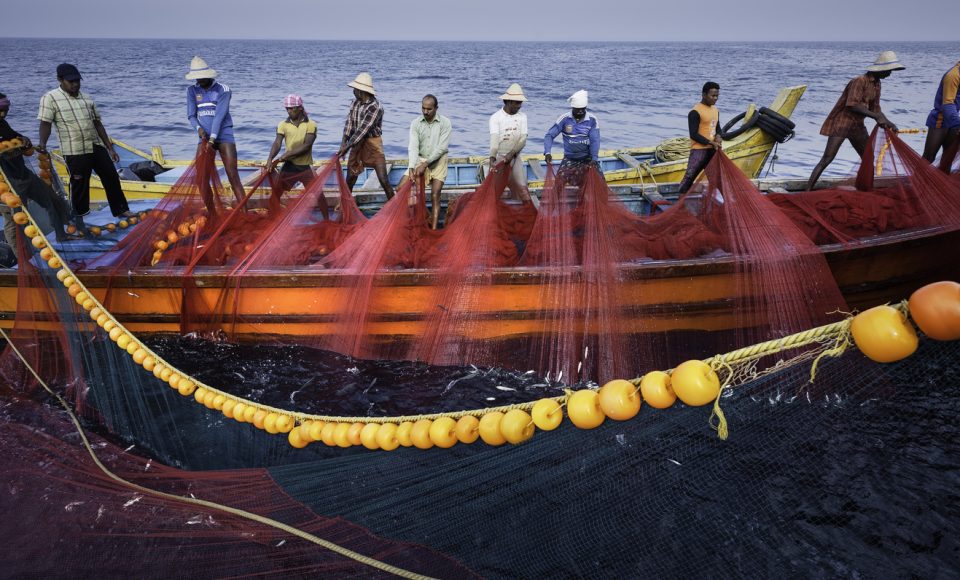
New deep-sea fishing rules favour corporates, rue small-scale fishers
The new policy gives priority to big vessels, helping mega corporates enter the fishing sector, say small-scale fishers; they also want the permit process decentralised

Jobith, a fisherman from Tamil Nadu’s Kanyakumari district, has ventured into the sea in his boat, heading to Kochi from Nagercoil. When The Federal reached out, he had started sailing from home to Kochi harbour, from where he filled up the oil tank and packed food to survive for the next one month.
Typically, Jobith and his 14 co-workers spend 30 to 45 days in the high seas for fishing. They go to the high seas around 700 nautical miles away from the coast. They fish there, competing with fishing ships from Iran, Oman and China.
Also read: Tamil fishing communities set example of interfaith coexistence
Fishermen’s concerns
“We do fishing in the high seas. Usually, the fishermen-sailors from other countries consider the sea as everyone’s property. Though there are gigantic ships of foreign countries, we manage to catch fish worth ₹15-20 lakh,” Jobith told The Federal. They make a profit of ₹5-10 lakh, which is shared among all the workers, he added.
However, Jobith is clueless about what is in store once the new policy on deep sea fishing becomes law.
The draft policy note, published by the Central Fisheries Ministry on August 30, triggered unrest among hundreds of small-scale fishermen like Jobith. “The new policy gives priority to big vessels as far as I know. More companies and corporates will enter into fishing. It will become difficult for small-scale fishers,” said Jobith, expressing his worries to The Federal.
Also read: India asks Sri Lanka to exercise caution while handling fishing boats
According to the guidelines of the Food and Agriculture Organisation (FAO), vessels with lengths less than 25 metres are categorised as ‘small-scale’.
The fishermen’s communities in Tamil Nadu and Kerala collectively share the same concerns. “The new policy is drafted with an intention of corporatising the fishing sector. The traditional small-scale fishermen will be kept away from high seas, which will eventually make them leave the occupation,” said Charles George, president of All India Deep Sea Fishers’ Association.
What guidelines say
The Guidelines for Regulation of Fishing by Indian Flagged Fishing Vessels in the High Seas, 2022, was published on the website of the Union Fisheries Department on August 30 and suggestions were invited.
There is much apprehension among the fishermen and experts in the field on the new guidelines. It has been suggested that it should be modified to make it more fishermen-friendly; currently, it’s seen as more ‘industrial friendly’.
Watch: Deep sea fishing scheme runs into troubled waters
The guidelines stipulate that all Indian flagged vessels require a permit to fish in the high seas. Those with a length of 25 metres or more are required to pay ₹5 lakh as fee. Boats between 15 and 24 metres in length have to pay ₹1 lakh to get a permit. The fee prescribed for vessels with lengths less than 15 metres is ₹50,000.
The All India Deep Sea Fishers’ Association, in a letter to the Union government, has demanded that these provisions be reviewed and the fee reduced.
The government has not even updated the number of Indian vessels engaged in fishing, said the association. The preamble states that there are 40 million fishermen in India.
Also read: Tamil Nadu fishermen: Netting plenty, living in poverty
“Even the preamble of the guidelines needs to be updated. There are 315,000 cannons being operated in India, which indicates that the actual number of fishermen is much greater than that mentioned in the policy draft. In the international sea alone, there are roughly 1,000 boats. All of them are about 20-22 metres in length and come under the category of small-scale fishing,” said George.
According to the association, almost 100 per cent of vessels belonging to small-scale fishermen have lengths less than 25 metres.
Centralised process
The new draft policy also centralises the process of getting permission. The authority empowered to grant permits is the Union government, per the new policy.
The definition clause of the draft policy makes it clear. “The issuing authority is the Department of Fisheries, Ministry of Fisheries, Animal Husbandry and Dairying, Government of India, or any other Issuing authority as authorised by the Department of Fisheries, Ministry of Fisheries, Animal Husbandry and Dairying, Government of India on its behalf”.
“Every fisherman from the other end of the country cannot go to Delhi to get a permit. This has to be decentralised,” M Majeed, secretary of the All India Deep Sea Fishers’ Association told The Federal. The association has demanded that the licence issuing authority be the respective state fisheries departments.
Marine exports decline
India is the second largest country in the production of fisheries and aquaculture (8 per cent), following China (35%).
Also read: Troubled waters: Church, State, and the fight over Kerala’s fishing communities
According to the 2022 report of the FAO, ‘The State of World Fisheries and Aquaculture (SOFIA)’, India’s marine exports have shown a declining trend.
“India had become the fourth major exporter in 2017. However, India was overtaken by Chile in 2020 as the value of India’s exports has been on a downward trend since 2018. In 2020, the total value of India’s exports of aquatic products reached $5.8 billion, down from $7.2 billion in 2017,” stated the FAO report.


